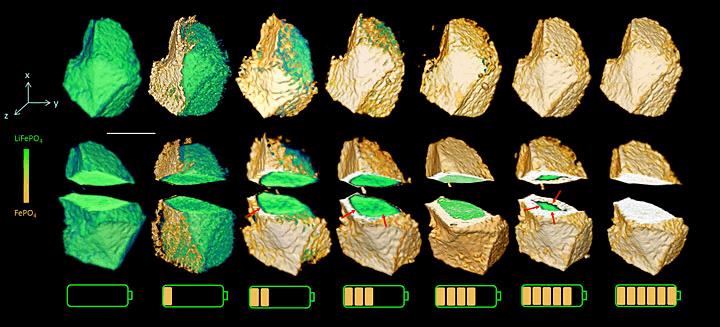New X-Ray Technique Reveals 5D Battery Images
By Jof Enriquez,
Follow me on Twitter @jofenriq

A new x-ray technique developed by scientists at the U.S. Department of Energy's (DOE) Brookhaven National Laboratory allows "five-dimensional" (3D space, plus time and energy) images of a battery as it charges and discharges.
Imaging the chemical transformation inside batteries is key to developing future types that perform better. However, conventional x-rays are unable to separate layers inside a battery while it undergoes chemical changes in real time. The scientists at Brookhaven, however, used a combination of X-ray tomography (to produce 3D images) and X-ray absorption near edge structure (XANES) spectroscopy (which is sensitive to chemical and local electronic changes) in order to produce a 3D model that changes shape over time at different X-ray energies.
"Were these images to have been taken with a standard two-dimensional method, we wouldn't have been able to see these changes," said research lead Jun Wang, a physicist at the National Synchrotron Light Source II, a DOE Office of Science User Facility, in a press release.
"Our unprecedented ability to directly observe how the phase transformation happens in 3D reveals accurately if there is a new or intermediate phase during the phase transformation process. This method gives us precise insight into what is happening inside the battery electrode and clarifies previous ambiguities about the mechanism of phase transformation," said Wang.
Wang and his team rotated the battery cell a full 180 degrees at each x-ray energy, with each scan producing a three-dimensional pixel called a voxel, the collection of which formed a chemical map in 3D, according to the press release. The scientists discovered that, at the start of charging, the lithium iron phospate transforms into phospate at an uneven pace and direction throughout the material. This becomes widespread as the battery becomes more highly-charged.

"A result of particular interest is the correlation between 3D phase transformation and electrochemical capacity, showing correspondence between single-particle processes and performance which can be exploited in future efforts in materials development," wrote the scientists in Nature Communications.
"Our methods for incorporating in situ electrochemical analysis can be potentially applied to other emerging imaging technologies such as lenseless coherent diffractive imaging to achieve higher spatial resolution, beyond X-ray optics resolution limits," they added.
The Brookhaven Lab engineers have been using the newly-opened National Synchrotron Light Source II (NSLS-II) to study catalytic reactions in real time using operandotechnique that may revolutionize research on catalysts, batteries, fuel cells, and other major energy technologies.
Another DOE Office of Science User Facility, Lawrence Berkeley National Laboratory (Berkeley Lab) Advanced Light Source, has also developed a new x-ray microscopy technique to study battery dynamics. Their approach allows imaging of nanoscale changes inside rechargeable lithium-ion battery particles as they charge and discharge.
